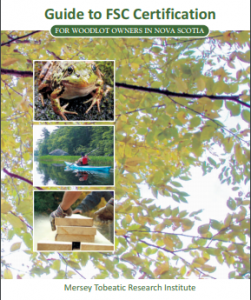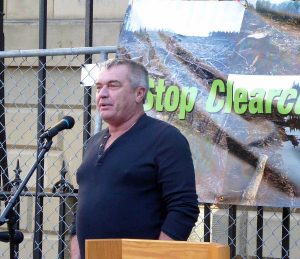 Kingsley Brown thinks the Report will recommend FSC certification, already implemented by many private woodlot owners, as the key to moving ahead, and expresses disdain for “the public’s unwarranted negativity” about forestry in Nova Scotia. But even FSC has a way to go to provide standards truly appropriate for Nova Scotia where we have the most intensive harvesting in Canada on some of the poorest soils.
Kingsley Brown thinks the Report will recommend FSC certification, already implemented by many private woodlot owners, as the key to moving ahead, and expresses disdain for “the public’s unwarranted negativity” about forestry in Nova Scotia. But even FSC has a way to go to provide standards truly appropriate for Nova Scotia where we have the most intensive harvesting in Canada on some of the poorest soils.
ADDENDUM (July 21, 2018): Kingsley Brown Responds
————————————-
Begin original post:
In an op-ed: COMMENTARY: Private landowners will play key role in N.S. forestry strategy (CH, July 17, 2018), Kingsley Brown, President of Nova Scotia Landowners and Forest Fibre Producers Association, provides lots of speculation about what the now long delayed Report on the Independent Review of Forestry Practices in Nova Scotia will recommend.
He refers to “a straw poll of private forest owners and managers” as the basis of some of his predictions:
– “Lahey is under no pressure to produce it, just to get it right”
– It will be a “somewhat radical, a continuum of radical advances toward modern environmentalism introduced by private landowners and implemented as “the only solution” by the province eight years ago — bottom-up, low cost, managed by forest owners, no public blowback.” He explains that “Within four years, the Rainforest Alliance, mother of the Forest Stewardship Council sustainability certification standard considered most responsible in the world, awarded eastern Nova Scotia landowners its highest prize for sustainable forestry. The two provincial FSC group certificates became one this year as the Nova Scotia Association for Woodland Certification. The get-it-right sentiment evolves from the last disastrous provincial review by homegrown partisans, and the current government’s anticipation that Lahey’s distinguished international panel will make the public’s unwarranted negativity go away. The public is generally fed up with forest practices.”
– “Our straw poll drew notions that the recent switch of forestry and environment ministers may mean recommendations for a stronger environmentalism — the province knows some of the panel’s thinking from the questions it was asked. Many look for changes of stewardship of our public lands.”
– “Registered professional foresters may be required for all Crown management plans.”
– “Wildlife and ecology requirements may go directly to Department of Environment”
– “FSC will likely be required on all Crown lands. ”
– “There may be some type of independent audit to determine if clearcutting is applied correctly.”
Kingsley Brown is pretty confident that FSC-certified private woodlots have already got it right and that Lahey heard their message.
He cites my speculation in a post on June 28 that the delay in getting the report out relates to “the need to make sure that the inducements/subsidies would not trigger NS losing its softwood exemption,” but argues:
But subsidies to whom and for what? The dynamic small private landowners’ program of environmental and financial sustainability needs short-term financial assistance for innovation and expansion. It’s designed for harvests, innovation and restoration services to pay for higher-value forests in the long run. Building on acclaimed success is a reasonable panel recommendation.
KB expresses some disdain, actually a lot, for those who have criticized forest practices in NS referring to “Nova Scotia’s much-maligned forest practices”, the “The get-it-right sentiment” which he says evolved “from the last disastrous provincial review by homegrown partisans” (reflecting the view of Independent Review Advisor Peter Duinker on that score), and “the public’s unwarranted negativity”. On that score, he is also confident he has got it right:
As for negativity in the forest community itself, Lahey called a special meeting ostensibly of forest innovators to resolve “conflict and polarization” among all sectors, large and small. The turnout was a perfect representation of the province’s forest industry, including a forester representing the Ecology Action Centre. Professional facilitators called out, “Let’s hear it. Where’s the conflict?”
There was none, in a forum noted for frankness and protecting turf for generations. Not a peep. Lahey was there. Before the meeting was over, small private landowners proposed and laid out a co-operative public infrastructure for Nova Scotia’s 2020 forest strategy. Real development is a DIY project.
Woods and Waters Nova Scotia made a post about the KB op-ed on July 17 which elicited some reactions to the “unwarranted negativity” comment and another version of what went on at the “special meeting”; on the latter, ML comments:
I participated in the “special meeting” that Mr. Brown is referencing and i believe that he has misrepresnted aspects of the dynamic and outcomes. For example, there were no representatives foresters from the Ecology Action Centre present, so I assume he was either referring to me or a man who worked for them years ago. Also, the polarization was, and still is, very much apparent. Some are calling for a total ban of clearcutting while others say that it is a practice based in ecological values and a regime of natural disturbance. There is a lot of us vs. them mentality wherein folks become entrenched in their opinions and shut down to discussion. The lengthy debates that occur on this page are evidence of this, from both sides. I have also been on the receiving end of personal attacks from one of the provinces largest mills because of my criticism and rejection of the status quo in NS forestry. I have been called a “tree hugger” (as though that’s a bad thing) by some who won’t recant their intended insult even after I declare that I have worked in forestry and arboriculture in various capacities for about 10 years and killed over 1,000,000 trees in the process. If that’s no polarization, I don’t know what is…
It’s hard to see how KB’s comments about “unwarranted negativity” and “homegrown partisans” can help to bring the peace he envisions once Prof Lahey proceeds in the direction KB is convinced he will go.
I would like to think that FSC certification really could ensure the quality of forest practices that would bring peace to the woods of Nova Scotia. However, as I have noted in other posts, there are some issues that have not been resolved by those standards.
View
– Science issues and lack of landscape/watershed level planning by Nova Scotia DNR limit what can be achieved through forest certification (Post, Feb 22, 2018).
– NSP, PHP, NSDNR and FSC appear to be complicit in burning primary biomass from Loon Lake area, increasing GHG emissions, and calling practices “sustainable” (Post, Mar 17, 2018)

Danny George, not FSC, blew the whistle on cutting of Old Growth on FSC-certified Crown lands in eastern Nova Scotia
Also, pursuant to the whole fiasco around cutting of Old Growth on FSC-certified lands in the region of Loon Lake in eastern Nova Scotia, I have to ask the question: why didn’t FSC-certification ensure that didn’t happen?
View: Nova Scotia DNR almost admits serious errors; Port Hawkesbury Paper blames DNR for Loon Lake area cuts of Old Growth
I do agree with KB that independent certification of practices is key to improving forestry practices in NS, but FSC still has a way to go in development of standards appropriate for Nova Scotia where we have the most intensive harvesting in Canada on some of the poorest soils, two aspects of forestry peculiar to Nova Scotia that are not specifically recognized in FSC documents related to Nova Scotia. (I have been raising these issues with FSC officials in the hope they will begin to address them.)
On the speculation about what the report will produce (including my own)… let’s hope Prof Lahey will soon put an end to it!
—————————————–
KB wrote me saying that he felt I had mis-represented his views, so I invited him to write a response, which he did, below.
KINSLEY BROWN RESPONDS (July 21, 2018):
“There was no ‘disdain’ for anyone or anything in my published commentary. The Province commissioned Dr. Lahey to review forest practises mainly to make “unwarranted” negativity go away. Unwarranted in the sense of misconceptions affecting responsible forest management. I said clearly ‘The public is generally fed up with forest practises.’
“Explanations can’t make everyone understand. Publics often accept what they want to believe. As for EAC at the final review meeting, forester Matt Miller said, at the identifying go-around, he was attending ‘wearing my Ecology Action Centre hat,’ as he has at other forestry venues. It was good he was there. Environmentalists support restoration of the Acadian Forest to the world’s most responsible standard.
“I sent the piece to the Herald because no one had bothered asking landowners what they thought of a nearly five-month overdue report making changes affecting their futures. Now they know, including a few nudges to Dr. Lahey. By publishing a forestry contribution overnight, the Herald thought it was time, too.
“Comment about the FSC standard needing improvement is trite. All certification standards involve raising the bar. As a member of FSC’s international sustainability consultation committee in Bonn, our association has changed procedure and taken up issues successfully face-to-face with FSC New York. Our commentary suggested ways, in the fourth paragraph, to strengthen the standard.
“Woodlot owners have no room for nuance and nibbling at their innovative and dynamic program, praised by the federal government as a ‘model for the world.’ The associatIon is hard-pressed to keep up with demand for services. Forest guardians Ray Plourde, Jamie Simpson and Bob Bancroft gave it their approval at their public meeting in Antigonish. It should be good enough for all Nova Scotians.”
